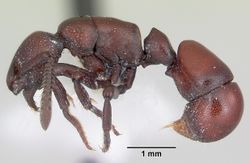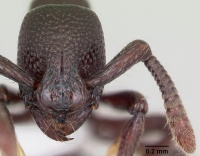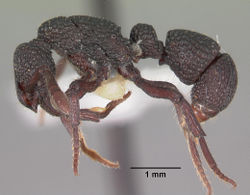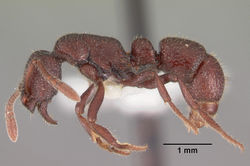Key to Loboponera Species
This key modifies Bolton & Brown (2002)[1] to include Loboponera nobiliae, described in Fisher (2006)[2], covering all the described species for the genus
You may also be interested in
1
- Dorsum of alitrunk and first gastral tergite without standing hairs of any form. Second gastral tergite punctate or with tine dense sculpture but without longitudinal costate sculpture. With head in full-face view the sides without projecting hairs …..2
- Dorsum of alitrunk and first gastral tergite with numerous to abundant stiff, usually short, standing hairs. Second gastral tergite with coarse longitudinal costate sculpture. With head in full-face view the sides with at least 1-2 short projecting hairs …..4
2
return to couplet #1
- Leading edge of scape without projecting hairs: dorsum of scape finely and densely punctulute. Dorsal surfaces of head and body, including the frontal lobes, entirely blanketed with very line dense sculpture, opaque. Propodeal lamella restricted to lower hull of declivity .....Loboponera trica
- Leading edge of scape with a row of suberect projecting hairs; dorsum of scape longitudinally costulate-rugulose. Dorsal surfaces of head and body not entirely finely densely sculptured, not opaque. Propodeal lamella extends the whole depth of the declivity …..3
3
return to couplet #2
- With petiole in profile the dorsum rising medially to a bluntly subpyramidal point. Scape longer, SI > 95; when laid back the apex of the scape just reaches the occipital margin. Larger species. HW > 0.90 .....Loboponera obeliscata
- With petiole in profile the dorsum shallowly convex to flat, not rising to a median subpyramidal point. Scape shorter, SI < 90: when laid back the apex of the scape distinctly fails to reach the occipital margin. Smaller species. HW < 0.70 .....Loboponera politula
4
return to couplet #1
- First gastral sternite with a mid-ventral longitudinal cuticular crest or carina that may extend entire length of sternite or be restricted to posterior half; carina usually partially to entirely translucent and clearly visible in profile …..5
- First gastral sternite without a mid-ventral longitudinal cuticular crest or carina that is partially to entirely translucent and clearly visible in profile …..7
5
return to couplet #4
- Base of gaster deeply concave when viewed from above and slightly to the front; on each side the tergite at its lowest point, at about the level of the helcium, projects forward and curves medially, forming a strongly defined incurved lobe .....Loboponera basalis
- Base of gaster transverse to shallowly concave when viewed from above and slightly to the front; on each side the tergite at its lowest point, at about the level of the helcium, forms a simple angle and does not project forward and curve medially as an incurved lobe …..6
6
return to couplet #5
- In dorsal view first gastral tergite coarsely foveolate, not costulate; spaces between foveolae raised and flat, entirely covered with tine dense shagreenate sculpture, dull and opaque. Longitudinal costae of second gastral tergite densely shagreenate and opaque. Eye large, with > 10 ommatidia in its maximum diameter and that diameter greater than maximum width of second funicular segment .....Loboponera vigilans
- In dorsal view first gastral tergite predominantly longitudinally costulate or rugulose, with scattered foveolate punctures between the costulae/rugulae: entire surface glossy, without dense opaque shagreenate sculpture. Longitudinal costulae of second gastral tergite glossy, not densely shagreenate and opaque. Eye small, with < 10 ommatidia in its maximum diameter and that diameter less than maximum width of second funicular segment .....Loboponera nasica
7
return to couplet #4
- Propodeal declivity with a small tubercle above a larger more basally situated tooth. Side of head behind and below eye sculptured with large, broad-rimmed coarse foveolate punctures, not costulate. With head in profile the lower occipital curve with a large lobate cuticular flange that is much broader than the maximum diameter of the eye …..8
- Propodeal declivity unarmed and smoothly rounded above a basally situated tooth. Side of head behind and below eye sculptured with fine longitudinal costulae and scattered small foveolate punctures. With head in profile the lower occipital curve with a small shallow cuticular crest that is narrower than the maximum diameter of the eye .....Loboponera edentula
8
return to couplet #7
- Pilosity about the same length than the the maximum width of the eye. The sculpture on the dorsum of the propodeum and petiole is partially effaced .....Loboponera subatra
- Pilosity is distinctly longer than the maximum width of the eye. The sculpture on the dorsum of the propodeum and petiole is distinct .....Loboponera nobiliae
References
<references>
- ↑ Bolton, B.; Brown, W. L., Jr.. 2002. Loboponera gen. n. and a review of the Afrotropical Plectroctena genus group (Hymenoptera: Formicidae). Bull. Nat. Hist. Mus. Entomol. Ser. 71: 1-18.
- ↑ * Fisher, B.L. 2006. Boloponera vicans gen. n. and sp. n. and two new species of the Plectroctena genus group. Myrmecologische Nachrichten 8: 111-118.

















